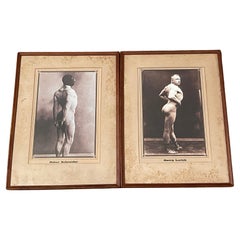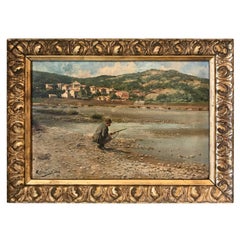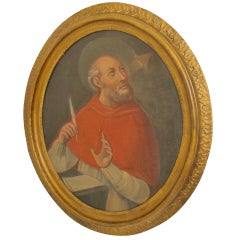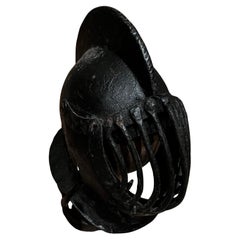Grinard Collection Sports Equipment and Memorabilia
to
3
3
3
1
2
1
1
3
1
1
1
1
2
1
1
1
1
3
3
3
Pair of 19th Century Scottish Monogramed Hardwood Lawn Balls
Located in West Palm Beach, FL
Pair of 19th Century Scottish Monogrammed Hardwood Lawn Balls
A pair of 19th-century Scottish monogrammed hardwood lawn balls. Each ball, measuring 5 inches in diameter, is crafted...
Category
Antique Late 19th Century Scottish High Victorian Sports Equipment and M...
Materials
Hardwood
$416 Sale Price / set
20% Off
Pair of Greco Roman Tournament Posters of Oskar Schneider & Georg Lurich, Nude
Located in West Palm Beach, FL
Pair of Greco Roman Tournament Posters of Oskar Schneider & Georg Lurich , Nude
Russia, Pre 1915
The pair of Tsarist Russian Tournament Posters depicting Osk...
Category
Early 20th Century Russian Sporting Art Sports Equipment and Memorabilia
Materials
Glass, Wood, Paper
$1,196 Sale Price / set
20% Off
19th Century Spanish Sporting Painting by E.Gioquinto, 1892
Located in West Palm Beach, FL
19th century Spanish sporting painting by E.Gioquinto, 1892, a finely painted gem of a hunter on a lake
Measures: Oil on board 11.5" x 8.5"
Giltwood frame 14" x 10".
Category
Antique 1890s Spanish Sporting Art Paintings
Materials
Wood, Giltwood
$1,516 Sale Price
20% Off
Related Items
18th Century, Spanish Colonial Religious Painting of San Geronimo
Located in San Francisco, CA
18th century painting of San Geronimo, oil on canvas laid on wood board. It was later placed in a restored 19th century wood and gesso frame. There is no signature.
Category
Antique 18th Century Unknown Spanish Colonial Paintings
Materials
Canvas
Antique Rare Italian Renaissance Tournament Helmet 1520-1550 with Original Stand
Located in Doha, QA
An exceptionally rare and evocative 16th- century Gothic Italian (Pisa) tournament helmet, forged entirely in wrought iron, weight 2.9 kg and presented together with its original pe...
Category
Antique 16th Century Italian Renaissance Arms, Armor and Weapons
Materials
Wrought Iron
$22,500
H 11.42 in W 7.09 in D 10.24 in
19th Century Bocce Balls, France, Set of Three
Located in Point Richmond, CA
Late 19th to early 20th century bocce balls, France, set of three
boxwood, iron and brass nails.
The first ball has the letters PP in brass, the second ha...
Category
Antique Late 19th Century French Folk Art Game Boards
Materials
Brass, Iron
Rare 19th Century English Tunbridgeware Hair Pin or Slide
Located in Dallas, TX
PRESENTING an EXTREMELY UNIQUE and RARE 19C British Tunbridgeware Hair Pin/Bobbin or Slide.
This slide is unlike any of it’s kind we have seen before, it is a VERY RARE survivor.
From circa 1860 – 80 and made in Tunbridge Wells, England.
Made of walnut with gorgeous marquetry inlay on the entirety of the front with classic Tunbridgeware micro-mosaic all over the front. The rear is walnut.
The marquetry inlay appears to be various different woods, namely, maple, walnut and satinwood.
Would have been worn in a Lady’s hair bun with the micro-mosaic facing forward.
This would have belonged to a VERY ELEGANT LADY in the mid to late 19th Century.
Tunbridge ware is a form of decoratively inlaid woodwork, typically in the form of boxes, that is characteristic of Tonbridge and the spa town of Royal Tunbridge Wells in Kent in the 18th and 19th centuries. The decoration typically consists of a mosaic of many very small pieces of different coloured woods that form a pictorial vignette. Shaped rods and slivers of wood were first carefully glued together, then cut into many thin slices of identical pictorial veneer with a fine saw. Elaborately striped and feathered bandings for framing were pre-formed in a similar fashion.
There is a collection of Tunbridge ware in the Tunbridge Wells Museum and Art Gallery in Tunbridge Wells.
The famous makers of Tunbridge ware were in the Tunbridge Wells area of Kent; their most notable work was from circa 1830-1900.
Early makers of Tunbridge ware, in Tunbridge Wells in the mid-18th century, were the Burrows family, and Fenner and Co. In the 19th century, around 1830, James Burrows invented a technique of creating mosaics from wooden tesserae. Henry Hollamby, apprenticed to the Burrows family, set up on his own in 1842 and became an important manufacturer of Tunbridge ware, employing about 40 people.
Edmund Nye (1797–1863) and his father took over the Fenner company when William Fenner retired in 1840, after 30 years in partnership with him. Thomas Barton (1819–1903), previously apprenticed at the Wise factory, joined the Nyes in 1836, and worked as Nye’s designer; he took over the business in 1863 and continued there until his death.
In Tonbridge (near to Tunbridge Wells), George Wise (1703–1779) is known to have had a business in 1746. It continued with his son Thomas, and Thomas’s nephew George (1779–1869), who took over in 1806. In its early years the company made articles such as workboxes and tea caddies with prints of popular views; later items had pictures created from mosaics. Their workshop in Tonbridge, Wise’s Tunbridge Ware Manufactory, was next to the Big Bridge over the Medway; the building was demolished in 1886 to widen the approach to the bridge.
Tunbridge ware became popular with visitors to the spa town of Tunbridge Wells, who bought them as souvenirs and gifts. Articles included cribbage boards, paperweights, writing slopes, snuffboxes and glove boxes.
At the Great Exhibition of 1851, Tunbridge ware by Edmund Nye, Robert Russell and Henry Hollamby was shown; Edmund Nye received a commendation from the judges for his work. He exhibited a table depicting a mosaic of a ship at sea; 110,800 tesserae were used in making the picture.
The manufacturers of Tunbridge ware were cottage industries, and they were no more than nine in Tunbridge Wells and one in Tonbridge. The number declined in the 1880s; competent craftsmen were hard to find, and public tastes changed. After the death of Thomas Barton in 1903 the only surviving firm was Boyce, Brown and Kemp, which closed in 1927.
Marquetry was an old technique which was continued by Nye and Barton to create images such as birds or butterflies.
‘Green Oak’ as caused by the fungus Chlorociboria aeruginascens.
Stickware and half-square mosaic was invented by James Burrows in about 1830: a bunch of wooden sticks of different colours, each having triangular or diamond-shaped cross section, were tightly glued together; in the case of stickware, the resulting block was dried, then turned to form an article such as the base of a pincushion. For half-square mosaic, thin slices were taken from the composite block, and applied to a surface.
Tesselated mosaic, was a development by James Burrows of half-square mosaic; it was adopted by George Wise and Edmund Nye. Minute tesserae were used to form a wide variety of geometric and pictorial designs.
Many sorts of wood were used for the various colours; about 40 were in regular use. Only natural colors were used; green was provided by “green oak”, produced by the action of fungus on fallen oak. Designs for articles were often taken from designs of Berlin wool work.
Category
Antique Late 19th Century English High Victorian Collectible Jewelry
Materials
Satinwood, Walnut
Early 20th Century Pair of English Lawn Bowls
Located in Chapel Hill, NC
Early 20th century pair of lawn bowls in original case, English. Lignum vitae bowls in leather travel case with expected wear. Marked "MM" & "B".
Case: 10.5" w., 7.5" h., 5 3/8" d.
...
Category
Early 20th Century English Edwardian Sports Equipment and Memorabilia
Materials
Leather, Wood
Golf, US Masters 1988 Tournament Badge
Located in Oxfordshire, GB
Augusta National Golf Club, US Masters 1988 Tournament Badge.
A pre-owned 1988 US Masters Golf Tournament spectators badge. The eventual winner ...
Category
20th Century American Sports Equipment and Memorabilia
Materials
Paper
Pair of Turkish 19th Century Antique Ottoman Embroideries
Located in London, GB
A pair of Turkish 19th century antique Ottoman embroideries
Turkey, 19th century
Small: height 31cm, width 37cm, depth 0.5cm
Large: heigh...
Category
Antique 19th Century Turkish Islamic Religious Items
Materials
Fabric
Antique 19th century carved hardwood rosary
Located in Bilzen, BE
A rosary complete made from hardwood in the 19th century
each ball is decorated with turned cirkels and have a diameter between 1 and 1.5 cm
The cross is 6.5 x 3.5 cm
Category
Antique 19th Century French Folk Art Religious Items
Materials
Wood
Pair of 19th C. Italian Reliquaries
Located in Los Angeles, CA
19th century pair of ornate gilded relicquaries made of brass with a gilt finish.
The feature highly decorative Baroque or Rococo-style detailing, including intricate scrollwork, f...
Category
Antique 19th Century Italian Baroque Religious Items
Materials
Brass
19th century American Southern Portrait by Benoni Irwin
By Benoni Irwin
Located in Savannah, GA
Oil on canvas portrait entitled:Mr. Bowles of Kentucky, painted by Benoni Irwin (1840-1896) an American portraitist born in new market, Ontario, Canada. He moved to New York as a you...
Category
Antique Late 19th Century American American Classical Paintings
Materials
Wood
$5,995 Sale Price
50% Off
H 36 in W 29 in D 3 in
Pair of Late 19th Century English Riding Boots
Located in Chicago, IL
This striking pair of late 19th-century English black leather riding boots is a handsome relic of the sporting life. Crafted with exceptional care, the boots retain their original fo...
Category
Antique Late 19th Century English Edwardian Sports Equipment and Memorab...
Materials
Leather, Wood
French Virgin and Child Chromo-Lithograph, Late 19th Century
Located in Labrit, Landes
Virgin and child chromo-lithograph, French, late 19th century
Golden frame
Good antique condition
For shipping: 5 x 31.5 x 47.5 cm 0.8kg.
Category
Antique Late 19th Century French Napoleon III Religious Items
Materials
Wood




